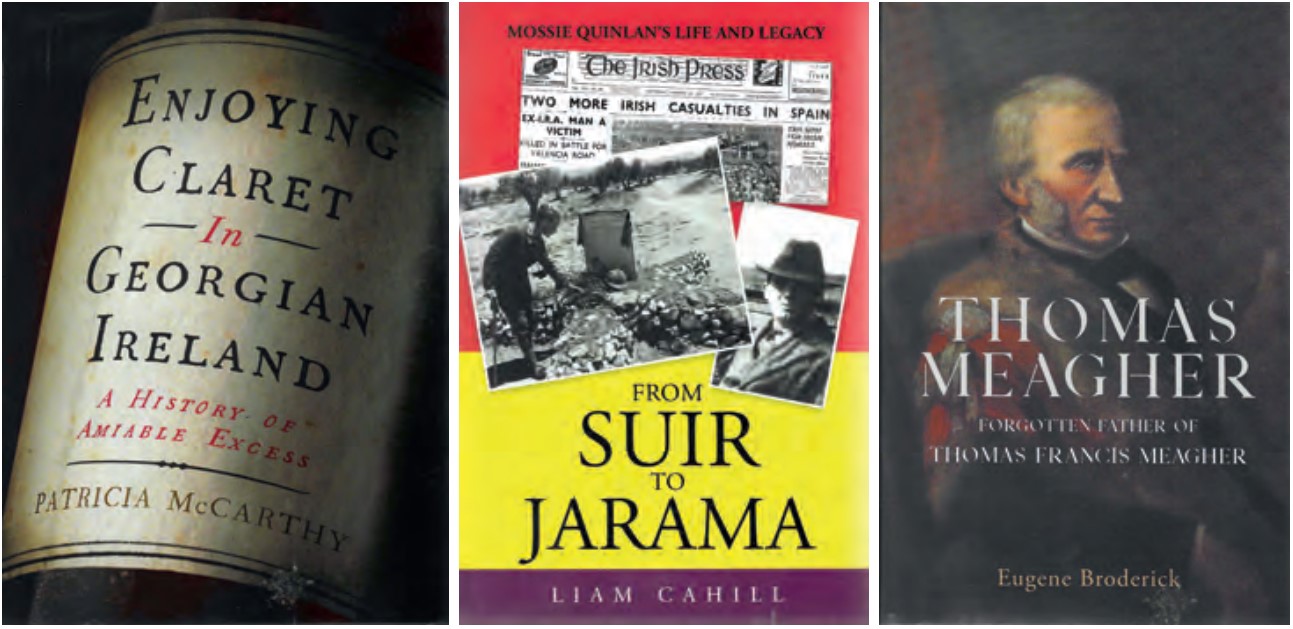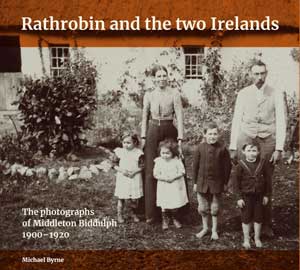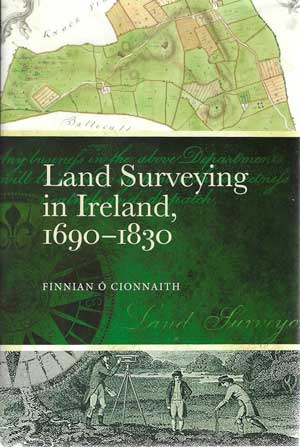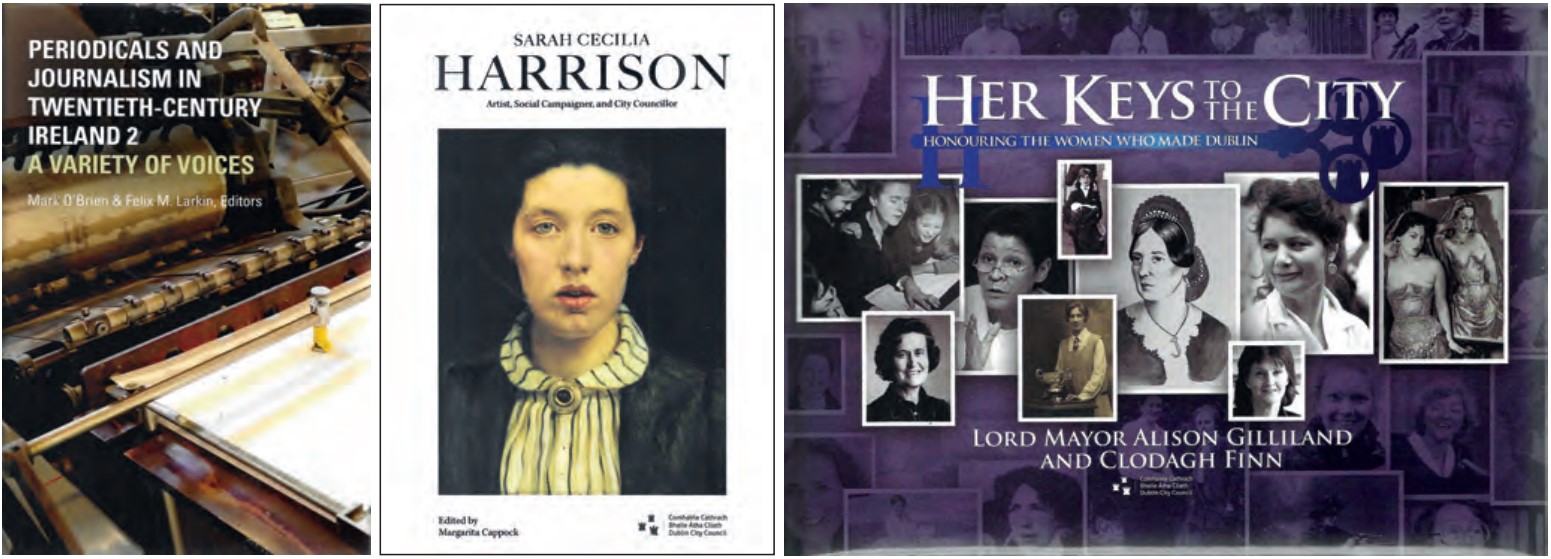BOOKWORM
Published in Book Reviews, Book Reviews, Issue 5 (September/October 2022), Volume 30By Joe Culley
@TheRealCulls
Lord Robert Ponsonby Tottenham, bishop of Clogher, suffered from a skin condition and was recommended to immerse himself in a bath of red wine each evening. However, unknown to the bishop, after his bath an enterprising servant duly decanted the contents into bottles and sold it in the village.
This glorious titbit is typical of Patricia McCarthy’s wonderful Enjoying claret in Georgian Ireland: a history of amiable excess. Profusely and gorgeously illustrated—special mention must be made of the cover design by Terry Foley—this small hardback is designed to sit comfortably on your coffee table. But, unlike many of its neighbours, you will have read every line of this.
Why was claret the favoured tipple in Ireland but not in Britain? It’s largely down to the Wild Geese and connections with Bordeaux; in the eighteenth century, one-fifth of the city’s chamber of commerce was Irish. Smuggling also played a role; from 1730-70 smuggled brandy accounted for one-third of spirits consumed here.
McCarthy tackles her subject in various themes, including the paraphernalia of wine drinking, the particular carry-on at Dublin Castle, the role of monasteries, and the medicinal, um, benefits of wine. Those of you (us) familiar with gout will ache in sympathy with the poor creatures. It’s a superb piece of work.
The former RTÉ political correspondent Liam Cahill, who recently died suddenly, was a hugely popular and committed trade unionist, political consultant, GAA man and historian of the Limerick Soviet. A native of Waterford, his final work, From Suir to Jarama: Mossie Quinlan’s life and legacy, tells the story of how his mother’s cousin could find himself fighting and dying for the Republicans in the Spanish Civil War.
Quinlan came from a family steeped in politics—his grandfather was a Sinn Féin mayor of Waterford—and, as a young man in the late 1920s, Mossie joined the IRA, the Republican Congress and the Communist Party of Ireland. You can see where this is headed. Suir to Jarama is a labour of love, in the best sense: a slim but enjoyably punchy homage to a brave man who represented an often-ignored strain of Irish life. Indeed, Cahill includes a sharp observation on how the Irish Independent chose not to report Quinlan’s death.
A previous incumbent of the office of Waterford mayor is the subject of Eugene Broderick’s easy-to-read Thomas Meagher: Forgotten Father of Thomas Francis Meagher. Born in Newfoundland, the son of a successful Irish emigrant, he was already thirty when he returned to and settled in Waterford in 1819. A fervent Catholic and constitutionalist, friend of O’Connell, in 1842 he was elected mayor, the first Catholic to hold this office since the seventeenth century. And so, how did he react when his radical son grabbed a sword and joined his confederate colleagues to march on Dublin?
The wonderfully named Middleton Westenra Biddulph (his brother was Assheton) was a retired British army lieutenant-colonel who lived on and managed the 1,000-acre Rathrobin estate in Offaly. It lay southwest of Tullamore, roughly half-way to Kinnitty. Around 1890, after over two decades abroad in loyal service to her majesty, Biddulph married and returned home to Offaly and determined to make progressive changes to life on the estate.
Immediately he began on alterations to the house itself, works which in time earned this description; ‘a wilfully haphazard, Arts and Crafts-inspired, Tudor Revival style, the result a chaotic jumble of mullion-windowed walls, with finial-topped, kneelered gables and dormers jostling around a square tower rising from the rear’.
The good news is Middleton was mad keen on photography, and in Michael Byrne’s Rathrobin and the two Irelands: the photographs of Middleton Biddulph 1900-1920 you can see the home in all its outlandish glory. Sadly, the house was burned in 1923.
As Byrne explains, the house was a target because, although Biddulph was, to his own mind, a benevolent and ‘improving’ landlord, he remained thoroughly English in attitude and never fully apprehended the extent of the revolution bubbling under.
But for nearly three decades Biddolph took photos of day-to-day life on the estate, everything from lavish hunting parties to images of his impoverished tenants working outside their thatched cottages. Few of the couple of hundred images in Rathrobin are remarkable, but as a collection they do offer an insight into a time and place on the cusp of revolution.
In Land surveying in Ireland, 1690-1830, Finnian Ó Cionnaith focuses on the work of three prominent men to examine how the fledgling profession developed in that century-and-a-bit between the end of violent land forfeiture (the plantations) and the establishment of the Ordnance Survey. Given how bureaucratic our modern, legalistic system is, it was slightly surprising to learn that these men operated as independent, commercial contractors, outside of any state control. It was also a time of great technical innovation. Ó Cionnaith writes: ‘What information we seek from the landscape and how we capture and present it is as much a reflection of ourselves and our culture as it is of the physical area in question.’ Ó Cionnaith writes well, and his own thorough ‘survey’ is presented in a nicely illustrated hardback.
In his entertaining contribution to Periodicals and journalism in twentieth-century Ireland 2: a variety of voices, Patrick Maume examines how the nationalism of the Catholic Bulletin can be traced right back to the Land War and even to O’Connell. While Maume looks briefly at the input of the Bulletin’s first editor, J.J. O’Kelly—Sceilg—he focuses more on that of his successor, Timothy Corcoran SJ. In one telling observation, Maume writes: ‘The Bulletin repeatedly attacked Eoin O’Duffy and the Blueshirts for not being proper fascists’.
Among the many other fine contributions, Joe Breen looks at the legacy of John Mulcahy and The Phoenix, while co-editor Mark O’Brien discusses the press of the gay rights movement.
Sarah Cecilia Harrison: artist, social campaigner, and city councillor is a wonderful study of yet another one of those outstanding women who have been allowed to almost evaporate from history. Born in County Down, and a grandniece of Mary and Henry Joy McCracken, by the age of fifteen Harrison was already enrolled in the Slade School in London and was quickly winning awards. In 1904 she had returned to Ireland permanently, and for the rest of her life juggled a career as a successful portrait artist with that of a political campaigner and social activist. This handsome book includes a catalogue of her work, much of which will be familiar even though you didn’t know whose it was.
In a similar vein, Clodagh Finn’s Her keys to the city: honouring the women who made Dublin showcases a variety of women, some familiar, others less so, who were central to major social and political changes. Included is women’s rights campaigner Anna Maria Haslam. You’ll recognise her when you see her, because her portrait was painted by—Harrison.
Patricia McCarthy, Enjoying claret in Georgian Ireland: a history of amiable excess (Four Courts Press, €36 hb, 224pp, ISBN 9781801510134).
Liam Cahill, From Suir to Jarama: Mossie Quinlan’s life and legacy (Orla Kelly Publishing, €8.99 pb, 126pp, ISBN 9781914225444).
Eugene Broderick, Thomas Meagher: forgotten father of Thomas Francis Meagher (Irish Academic Press, €29.95 hb, 340pp. ISBN 9781788552196).
Michael Byrne, Rathrobin and the two Irelands: the photographs of Middleton Biddulph 1900-1920 (Offaly History, €24.99, 310pp, ISBN 9781909822269).
Finnian Ó Cionnaith, Land surveying in Ireland, 1690-1830 (Four Courts Press, €31.50 hb, 272pp, ISBN 9781801510141).
Mark O’Brien, Felix M. Larkin (eds), Periodicals and journalism in twentieth-century Ireland 2: a variety of voices (Four Courts Press, €45 hb, 320pp. ISBN 9781846828621).
Margarita Cappock (ed.), Sarah Cecilia Harrison: artist, social campaigner, and city councillor (Dublin City Council, €20.65 pb, 266pp, ISBN 9781838463519).
Alison Gilliland (Lord Mayor), Clodagh Finn, Her keys to the city: honouring the women who made Dublin (Dublin City Council, €17.90 hb, 254pp, ISBN 9781838463557).




















